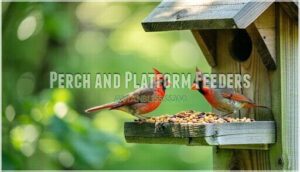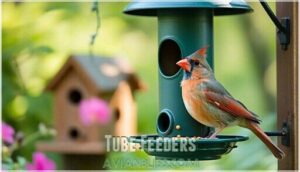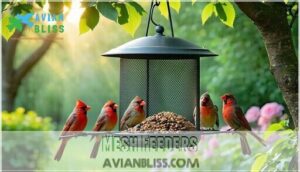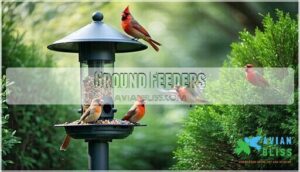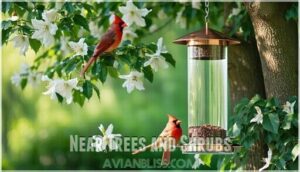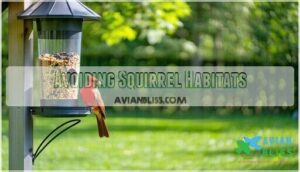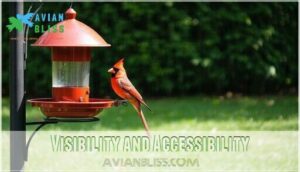This site is supported by our readers. We may earn a commission, at no cost to you, if you purchase through links.

Platform feeders, like the Woodlink Going Green, are great because cardinals prefer flat surfaces. Tube feeders with larger perches work too, as long as the openings fit cardinals’ beaks.
Squirrel-resistant models can keep unwanted visitors out. Place your feeder near trees or shrubs for safety, but avoid heavy squirrel traffic.
Keep it clean and filled, and cardinals will make your yard a regular stop. Curious about a top 10 list that works for cardinals? Stick around for better ideas!
Table Of Contents
- Key Takeaways
- Choosing Best Feeders
- Top 10 Cardinal Feeders
- 1. Woodlink Going Green Platform Bird Feeder
- 2. Droll Yankees Seed Saver Feeder
- 3. Droll Yankees Green Tube Bird Feeder
- 4. Squirrel Resistant Bird Feeder Beige
- 5. Wood Bird Feeder with Suet Cages
- 6. Gray Bunny Bird Squirrel Feeder
- 7. Amish Poly Ground Bird Feeder
- 8. Nature’s Hangout Window Bird Feeder
- 9. Woodlink Large Premier Going Green Feeder
- 10. Cedar Platform Tray Bird Feeder
- Feeder Design Considerations
- Optimal Feeder Placement
- Cardinal Feeding Tips
- Frequently Asked Questions (FAQs)
- What kind of feeders do cardinals prefer?
- What is the 5 7 9 rule for bird feeders?
- What height should a bird feeder be for cardinals?
- Why aren’t cardinals coming to my bird feeder?
- What is the best bird feed for cardinals and blue jays?
- Do cardinals recognize humans who feed them?
- How do you feed cardinals and not sparrows?
- What is the best bird feeder for Cardinals?
- What bird feeder does a cardinal eat?
- How do you attract Cardinals to a bird feeder?
- Conclusion
Key Takeaways
- Use red, spacious platform or hopper feeders for cardinals—they love open designs and visible seeds.
- Stock your feeder with sunflower or safflower seeds as they’re cardinals’ favorites and less attractive to squirrels.
- Place feeders near shrubs or trees for easy access and safety, but keep them away from heavy squirrel traffic.
- Clean and refill feeders regularly to keep seeds fresh and maintain a consistent feeding spot for cardinals.
Choosing Best Feeders
When you’re picking a feeder for cardinals, you need to understand their specific habits and preferences first.
Cardinals require wide platforms or large perches because they’re bigger birds with broader bodies, and they prefer open feeding areas where they can see their surroundings clearly.
Cardinal Feeding Habits
Cardinals start their morning frenzy at dawn, actively foraging for 12 hours daily.
You’ll notice they prefer ground-level feeding near protective cover, hopping through low branches.
Their foraging duration peaks between 9am and noon when seed visibility matters most.
Understanding these dietary needs helps during seasonal changes – they’ll visit cardinal bird feeders more frequently in winter when natural food becomes scarce.
Cardinal Food Preferences
Your feathered friends have distinct tastes regarding cardinal bird food.
Black oil sunflower seeds cardinals crave most, thanks to their thin shells and high fat content.
Safflower seeds cardinals also love, offer excellent squirrel resistance.
These preferred seeds work best in quality seed blends.
Cardinals enjoy ground feeding too, so scatter some below your feeder for natural foraging behavior.
Attraction Tips
Beyond food choices, you’ll want to use red feeder color to catch their attention naturally.
Red feeders are a natural beacon, drawing cardinals with their vibrant color and creating an irresistible feeding hotspot in your yard.
Place cardinal bird feeders near water source proximity and scatter seed ground scatter below for ground-feeding habits.
Plant shrub shelter planting nearby for safety cover.
The best cardinal feeders require fresh seed daily maintenance, keeping attracting cardinals feeders clean and stocked consistently.
Top 10 Cardinal Feeders
You’ll find these ten feeders work best for attracting cardinals to your yard. Each feeder offers specific features that match cardinals’ feeding habits and body size requirements.
1. Woodlink Going Green Platform Bird Feeder
This eco-friendly feeder checks all the boxes for cardinal lovers.
You’ll appreciate its 90% recycled plastic construction that won’t fade or rot in harsh weather.
The generous 16-inch platform holds 5.5 pounds of seed, giving cardinals plenty of room to perch comfortably.
Its screen bottom drains water naturally, keeping seeds fresh and mold-free.
The clear roof lets you monitor seed levels easily, while the hinged design makes refilling simple.
Cardinals flock to this feeder because it mimics their preferred ground-feeding style perfectly, with a design that is also eco-friendly.
Best For: Bird lovers who want a durable, eco-friendly feeder that attracts cardinals and supports ground-feeding styles.
- Requires regular cleaning to prevent seed buildup and mold.
- Screen bottom may need replacement after extended use.
- May attract unwanted birds like grackles depending on seed type.
- Made from 90% recycled plastic, resistant to weather and rot.
- Holds 5.5 pounds of seed with a large platform for up to 15 birds.
- Screen bottom ensures proper drainage to keep seeds fresh.
2. Droll Yankees Seed Saver Feeder
The Droll Yankees Seed Saver Feeder offers a durable, smart design for attracting cardinals and other small birds.
Its adjustable 10-inch dome keeps food dry and deters larger birds and squirrels, making it ideal for selective feeding.
The clear UV-stabilized polycarbonate construction prevents yellowing, while the wide tray accommodates seeds, suet, or mealworms.
It holds 1 pound of food, ensuring easy maintenance with drainage holes for freshness, and you’ll appreciate its lifetime warranty against squirrel damage.
The feeder also offers versatile hanging or pole-mounting options, making it a practical choice for various settings, with a design that includes drainage holes for freshness.
Best For: Bird enthusiasts who want a durable, adjustable feeder to attract small to medium birds while deterring larger birds and squirrels.
- Limited tray size holds only 1 pound of food.
- Requires occasional maintenance for dome stability.
- Some users feel the polycarbonate thickness could be better.
- Adjustable dome deters larger birds and squirrels.
- Durable, UV-stabilized construction resists yellowing and damage.
- Versatile mounting options for hanging or pole mounting.
3. Droll Yankees Green Tube Bird Feeder
The Droll Yankees Green Tube Bird Feeder is a reliable choice for attracting cardinals.
Its sturdy, UV-stabilized polycarbonate tube holds up to 5 pounds of seed, ensuring a steady supply.
The internal baffle prevents seed clogging, while six reinforced feeding ports comfortably accommodate multiple birds.
Durable zinc die-cast parts protect against weather and wear.
Hanging it’s easy, thanks to the metal loop hanger, while the wide-mouth reservoir simplifies filling.
It’s perfect for cardinals seeking easy access and birdwatchers wanting clear visibility.
Best For: Bird enthusiasts looking for a durable, easy-to-maintain feeder that attracts cardinals and accommodates multiple birds.
- Durable zinc die-cast and UV-stabilized polycarbonate construction.
- Internal baffle prevents seed clogging and ensures consistent flow.
- Wide-mouth reservoir and sliding cap make filling and cleaning simple.
- Mixed reviews on squirrel resistance despite design efforts.
- Smaller seed capacity compared to other available models.
- Sliding cap may occasionally cause usability concerns.
4. Squirrel Resistant Bird Feeder Beige
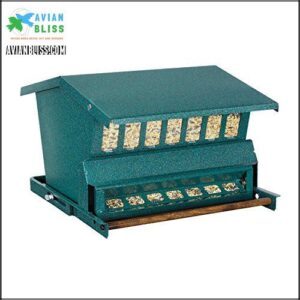
Looking for a practical bird feeder? The Squirrel Resistant Bird Feeder Beige is a standout option.
Its spring-activated perch cleverly blocks squirrels while welcoming smaller birds like cardinals. The 15-pound seed capacity means less refilling, and the powder-coated steel guarantees durability in any weather.
A locking top and no-waste seed saver baffle keep things tidy, while the included pole allows versatile placement. This helps keep pesky squirrels away.
However, the plastic base might struggle in freezing conditions, and a sturdier pole may be needed for soft soil.
Best For: Bird enthusiasts who want a durable, squirrel-resistant feeder with high seed capacity and easy maintenance.
- Durable powder-coated steel construction withstands harsh weather.
- Spring-activated perch effectively deters squirrels and larger birds.
- Large 15 lb. seed capacity reduces frequent refilling.
- Plastic base may become brittle in freezing temperatures.
- Pole included is not sturdy in soft soil.
- High price compared to other feeders, though quality justifies cost.
5. Wood Bird Feeder with Suet Cages
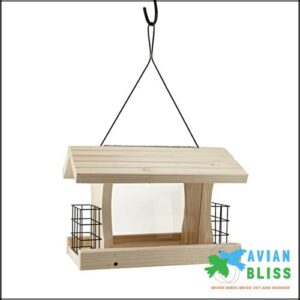
The Wood Bird Feeder with Suet Cages is perfect for attracting cardinals and other birds.
It holds up to 5 pounds of seed and two suet cakes, combining space and versatility.
Made from cedar, it’s durable and blends well with natural settings.
The hinged roof makes filling and cleaning easy, while clear windows let you monitor seed levels.
Though rain might enter through the roof hinge, it’s easily fixable, making this a sturdy feeder that supports multiple birds and brings life to your yard.
Best For: Bird enthusiasts who want to attract a variety of species like cardinals and woodpeckers while enjoying a durable, easy-to-maintain feeder.
- Holds up to 5 pounds of seed and 2 suet cakes, attracting multiple bird species.
- Made of cedar for durability and natural aesthetics.
- Hinged roof and clear windows for easy filling and seed level monitoring.
- Roof hinge may allow rainwater into the seed bin.
- Plexi sides can feel flimsy compared to the overall construction.
- Seed spillage may attract unwanted wildlife like squirrels and doves.
6. Gray Bunny Bird Squirrel Feeder
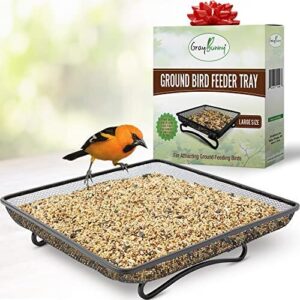 View On Amazon
View On Amazon The Gray Bunny Bird Squirrel Feeder is perfect for attracting cardinals and other ground-feeding birds.
Its steel mesh tray is durable and rust-resistant, letting water drain easily to keep seeds dry. Raised edges prevent messes, and two sturdy bars stop tipping.
It’s easy to clean, making maintenance a breeze. While it doesn’t deter squirrels, you can weigh it down with rocks.
This compact tray feeder is an excellent choice for backyards, offering cardinals a safe, comfortable place to dine.
Best For: Ground-feeding birds like cardinals and bird enthusiasts seeking an easy-to-maintain, durable feeder.
- Durable, rust-resistant steel mesh ensures long-lasting use.
- Raised edges prevent seed spillage and mess.
- Large feeding area easily accommodates multiple birds.
- Millet and small seeds may fall through the mesh.
- Sharp edges might need modification for bird safety.
- Does not deter squirrels and may require weighting to prevent tipping.
7. Amish Poly Ground Bird Feeder
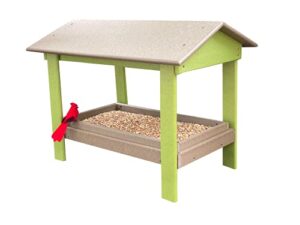 View On Amazon
View On Amazon The Amish Poly Ground Bird Feeder is a solid choice for attracting cardinals.
Made from eco-friendly, recycled poly lumber, it’s durable and built to endure weather challenges.
Its spacious platform and roof protect seeds while offering easy access for ground-feeding birds.
You’ll appreciate the low-maintenance design—no painting or staining required—and it’s easy to fill and clean.
Handcrafted by Amish craftsmen in Indiana, the feeder adds charm to your yard while supporting small businesses.
Its thoughtful design guarantees functionality and lasting value.
Best For: Outdoor enthusiasts and bird lovers looking for a durable, eco-friendly feeder to attract a variety of ground-feeding birds like cardinals.
- Made from weather-resistant, recycled poly lumber for durability.
- Spacious platform with a roof for seed protection and easy bird access.
- Low-maintenance, easy to clean, and supports small Amish businesses.
- Requires refilling frequently during peak bird activity.
- Attracts squirrels and other small animals in addition to birds.
- Ground placement may not suit all outdoor areas prone to flooding or high activity spots.
8. Nature’s Hangout Window Bird Feeder
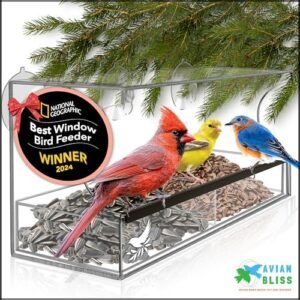
Nature’s Hangout Window Bird Feeder offers a front-row seat to birdwatching right from your window.
With its crystal-clear design and strong suction cups, it stays in place while attracting cardinals and other species.
The removable tray holds 4 cups of seed and allows for easy cleaning, and drainage holes keep seeds dry, even in rainy weather.
Place it five feet high, away from predators, for the best results, as it’s a squirrel-resistant, weatherproof option that’s perfect for connecting with nature effortlessly.
Best For: Birdwatching enthusiasts, nature lovers, and pet owners looking for a clear, easy-to-use feeder that attracts various bird species.
- Crystal-clear design for unobstructed birdwatching.
- Removable tray for effortless cleaning.
- Weatherproof and squirrel-resistant construction.
- Birds may take up to three weeks to locate the feeder.
- Can scatter seeds, requiring cleanup below the feeder.
- Photography can be challenging due to backlighting and shadows.
9. Woodlink Large Premier Going Green Feeder
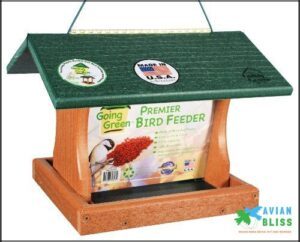
Looking for an eco-friendly choice? The Woodlink Large Premier Going Green Feeder is made from recycled plastic, so it’s durable and resists mold.
Its hinged roof makes filling and cleaning a breeze, and plexiglass sides let you keep an eye on seed levels. Holding up to 5.5 pounds of seed, it’s perfect for attracting cardinals.
The weatherproof design keeps seeds dry, and the hanging cable guarantees stability. It’s a solid pick for bird-lovers who want something sturdy, easy to maintain, and environmentally conscious.
Best For: Bird enthusiasts seeking a durable, eco-friendly feeder that can handle various weather conditions and attract a variety of bird species.
- Plastic windows may crack in extremely cold weather.
- Can be heavy for one person to hang without assistance.
- Prone to shipping damage like broken plexiglass panels.
- Eco-friendly construction using recycled plastic, resists mold and rot.
- Holds up to 5.5 pounds of seed with a weatherproof design to keep food dry.
- Hinged roof and easy-to-monitor plexiglass sides simplify cleaning and refilling.
10. Cedar Platform Tray Bird Feeder

The Cedar Platform Tray Bird Feeder is a solid pick if you want something durable and versatile for cardinals.
Made from rot-resistant cedar, its mesh bottom guarantees proper drainage, keeping seeds fresh.
The removable tray makes cleaning fuss-free, and it holds enough seed for a variety of birds, including cardinals.
You can place it on a table or hang it using the included wires.
While squirrels may show interest, this sturdy feeder offers great value and a reliable option for long-term birdwatching enjoyment.
Best For: Birdwatchers looking for a durable, easy-to-clean platform feeder that attracts a variety of bird species including cardinals.
- Rot-resistant cedar construction with stainless steel screws ensures long-lasting durability.
- Mesh bottom allows for proper drainage, keeping seeds fresh.
- Versatile design can be table-mounted or hung using included wires.
- Squirrels and chipmunks may frequently access the feeder.
- Nyjer seed can leak through the mesh bottom.
- May require extra nails to secure wood supports under the grid.
Feeder Design Considerations
When picking a feeder for cardinals, it’s all about size, accessibility, and stability.
You’ll want a design that gives these larger birds plenty of room to perch and easy access to their favorite seeds.
Perch and Platform Feeders
Platform feeders for cardinals work wonders by providing ample space and comfort.
Their perch design suits cardinals’ size perfectly.
When picking one, look for these features:
- Platform Materials: Cedar or metal resists weather and lasts.
- Seed Capacity: Holds lots of seed—less refilling.
- Cardinal Size: Spacious enough for their broad bodies.
- Weather Resistance: Keeps seed dry efficiently—perfect for all seasons.
Many options exist if you need a cardinal bird feeder.
Tube Feeders
Tube feeders aren’t the best cardinal bird feeders due to small openings and limited perch space.
Cardinals struggle with seed accessibility on these designs, leading to frustration and seed spillage issues.
While baffles can help deter squirrels, cleaning challenges make maintenance tricky.
Many enthusiasts still seek specialized tube options for cardinals. Though tube feeders suit smaller birds, cardinals often prefer feeders with open or larger platforms for comfort.
Open Feeders
Open feeders are exceptional for cardinals, offering easy access and visibility.
Their wide, open design suits cardinals’ feeding style, allowing multiple birds to feed calmly. These feeders simplify cleaning and reduce seed spillage.
Look for weather protection features to keep seeds dry. If you want the best cardinal feeders, platform feeders and hopper feeders for cardinals often fit the bill perfectly.
Mesh Feeders
Mesh feeders are a durable choice for bird feeders cardinals love.
Their design minimizes seed spillage while offering ease of cleaning. Look for mesh sizes that allow easy access for cardinals but prevent waste.
These feeders also support bird foot comfort. As seen in tray or platform feeders, cardinals enjoy open feeding spaces.
When picking the best cardinal feeders, prioritize material durability and make certain the feeder aligns with cardinal feeding tips for success.
Ground Feeders
Ground feeders work well for cardinals since they prefer low and open spaces.
Just watch out for ground safety concerns, like predators or weather damage.
To make the most of these feeders:
- Choose covered designs to prevent seed spillage and add weather protection.
- Place feeders near shrubs for predator risks and offer shelter.
- Pick models with easy cleaning features.
Optimal Feeder Placement
Placing your feeder in the right spot helps attract cardinals while keeping them safe and comfortable.
Choose areas near trees or shrubs for shelter, but far enough from squirrel habitats for added protection.
Near Trees and Shrubs
Positioning cardinal feeders near trees and shrubs makes perfect sense.
Branch support offers natural shelter and predator protection, creating a safe feeding space. Plus, the proximity boosts bird visibility while minimizing seed spillage with foliage barriers.
To prevent collisions, consider safe distances from windows.
Northern Cardinals feel more at ease near cover, so this feeder placement improves your chances of attracting cardinals while maintaining a vibrant, bird-friendly environment with natural shelter and predator protection.
Avoiding Squirrel Habitats
To keep squirrels away, use squirrel baffles under or above your feeders.
Set platform feeders for cardinals at least five feet high and avoid trees or fences that act as jumping points.
Choose squirrelproof cardinal feeders and seed types like safflower, which squirrels dislike.
Location awareness matters—physical barriers or pole-mounted feeders can prevent unwanted intrusions while still attracting cardinals effectively. You can find various squirrel-resistant feeder options online.
Visibility and Accessibility
When setting up your cardinal feeder, focus on clear sightlines and an open design for visibility.
Place the feeder at an ideal height, about 5-6 feet, with easy access for cardinals.
Choose red feeders to attract them and guarantee perch comfort.
Avoid dense bushes or barriers—this lets birds feel safe while you enjoy incredible views.
Cardinal Feeding Tips
If you want to keep cardinals visiting your yard, it’s important to focus on their specific needs.
From choosing the right feeding times to offering fresh water, small changes can make a big difference.
Feeding Times for Cardinals
Morning is when cardinals thrive at feeders.
Between 9 a.m. and noon, they’re most active, especially during peak hours as they search for sunflower and safflower seeds.
Juveniles often mimic adults, highlighting a strong social dynamic.
Seasonal variations and weather impact their behavior, so strategic cardinal feeder placement guarantees they visit regularly, even when environmental conditions shift.
Troubleshooting Feeder Issues
Issues like seed spoilage, clogged dispensers, or pest infestation can frustrate anyone attracting cardinals.
Regular bird feeder maintenance solves most problems.
Try these tips:
- Clean feeders weekly to prevent bird illness.
- Use squirrel-resistant designs to reduce feeder damage.
- Replace wet seeds; mold harms birds.
- Cover feeders to keep seeds dry.
- Place feeders strategically to minimize pests.
Attracting Cardinals With Water
A reliable water source draws cardinals just like quality bird feeders.
Offer shallow bird baths for safe drinking and bathing habits.
Change water daily, especially in summer, and clean weekly to prevent algae.
In winter, use a heated bath for consistent access.
Here’s a quick comparison of water source options:
| Water Source Types | Bathing Habits | Winter Water | Cleaning Frequency |
|---|---|---|---|
| Shallow Bird Baths | Frequent use | Needs heating | Weekly |
| Water Drippers | Enticing sound | Limited | Monthly |
| Heated Bird Baths | Rare splashes | Excellent | Bi-weekly |
| DIY Water Bowls | Moderate | Needs heating | As needed |
The table provides a summary of different water source options, including their characteristics and maintenance needs, to help you decide on the best water source for your bird feeder, considering factors like bathing habits and cleaning frequency.
Avoiding Cardinal Deterrents
To avoid scaring off cardinals, focus on three key areas:
- Pest Control: Use squirrel-resistant feeders with cardinal-friendly perches.
- Predator Avoidance: Avoid placing feeders near hiding spots for raccoons or cats.
- Seed Spoilage: Choose durable feeder materials and make certain they’re clean.
Keeping feeders at an ideal height and in quieter spots also helps attract cardinals.
Regular cleaning prevents disease spread among birds.
Frequently Asked Questions (FAQs)
What kind of feeders do cardinals prefer?
Think of cardinals as royalty—they prefer feeders like open trays, hoppers, or platforms, offering plenty of space.
Red designs catch their eye, while sturdy perches and visible seeds guarantee both comfort and convenience for these regal visitors, making them feel like true regal visitors.
What is the 5 7 9 rule for bird feeders?
The 5-7-9 rule suggests placing bird feeders 5 feet from the ground, 7 feet from cover (like shrubs), and 9 feet away from predators’ reach.
It guarantees birds feel safe while feeding comfortably.
What height should a bird feeder be for cardinals?
Imagine a welcoming perch, like a tree branch in the wild—hang your bird feeder 5-6 feet high.
This height deters predators, keeps seeds dry, and makes it easy for cardinals to feed safely.
Why aren’t cardinals coming to my bird feeder?
Cardinals might avoid your feeder if it’s too small, lacks red accents, or isn’t stocked with their favorite seeds like sunflower or safflower.
Place it in open, quiet areas near shelter for better results.
What is the best bird feed for cardinals and blue jays?
To keep both cardinals and blue jays flocking, serve black-oil sunflower seeds or sunflower hearts.
Add safflower seeds—they deter squirrels but attract these birds.
Choose blends combining them for less waste, or try peanuts for variety!
Do cardinals recognize humans who feed them?
Cardinals can recognize you if you consistently feed them.
They’ll associate your presence with food, showing up when you’re nearby.
Over time, they might even grow comfortable enough to stay while you refill feeders, and they will associate your presence with food.
How do you feed cardinals and not sparrows?
Place safflower seeds in a cardinal-specific feeder with weighted perches or squirrel-proof designs.
Sparrows dislike safflower, giving cardinals a chance to thrive.
Position feeders near shrubs for shelter, away from sparrows’ preferred open spaces.
What is the best bird feeder for Cardinals?
The Woodlink 3-in-1 Platform Feeder stands out for cardinals.
Its spacious tray suits their size, and it supports ground, hanging, or pole setups.
Durable cedar and a removable screen guarantee easy cleaning and versatile feeding.
What bird feeder does a cardinal eat?
Imagine a diner built just for you.
Cardinals love open platform or hopper feeders with wide spaces for their full-breasted bodies.
Pair it with sunflower or safflower seeds, and they’ll visit daily!
How do you attract Cardinals to a bird feeder?
To attract cardinals, use red-colored platform or hopper feeders with sunflower or safflower seeds.
Place feeders in open, quiet spaces near shrubs for cover.
Provide fresh water daily and keep feeders clean and stocked.
Conclusion
Selecting the best bird feeders for cardinals guarantees these beautiful birds visit your yard regularly.
Strong structures, spacious perches, and seed-friendly designs work best. Keep feeders near shrubs or trees for safety, but out of heavy squirrel zones.
Don’t forget freshness—clean and fill feeders often to keep cardinals coming back. With the right approach, you’ll create a welcoming space for these vibrant visitors.
Start with the top feeders on this list and enjoy the results!

